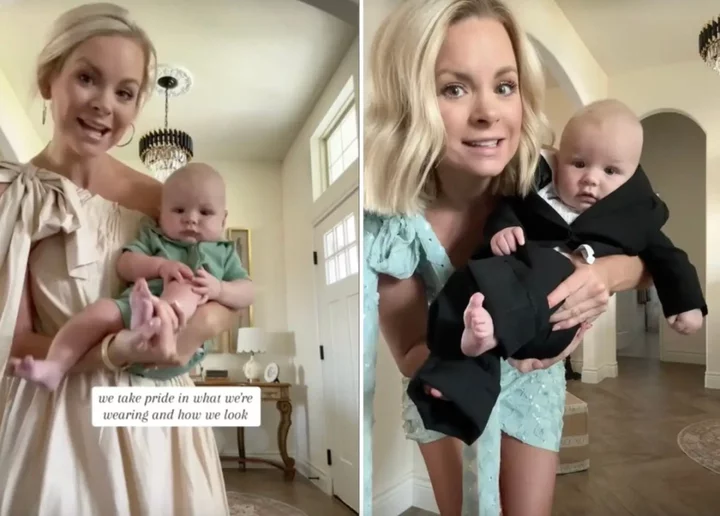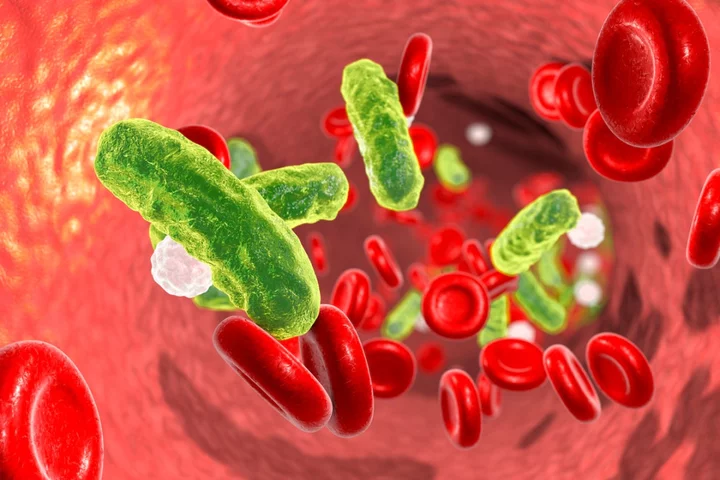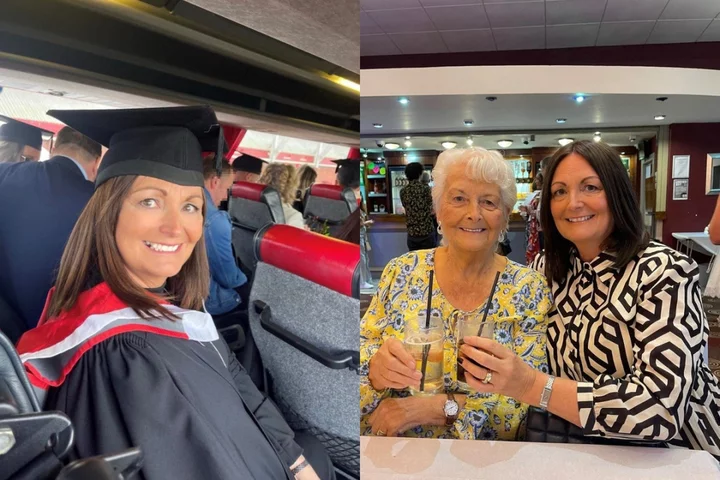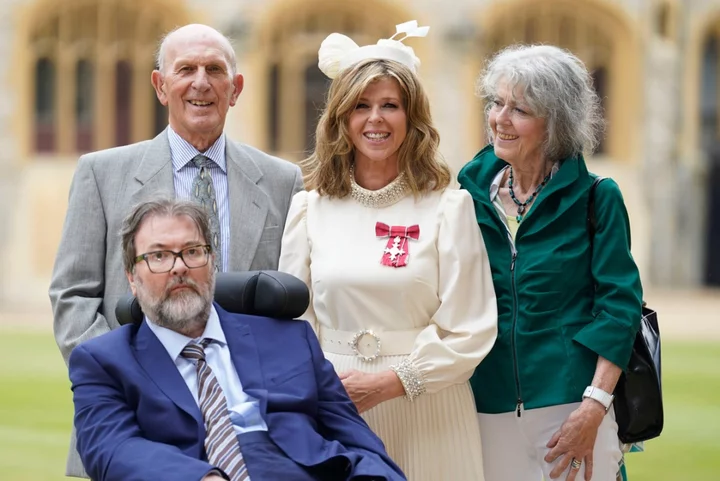
Josh Duhamel and wife Audra Mari announce they’re expecting first baby together
Josh Duhamel and his wife, Audra Mari, are welcome their first child together. The couple, who officially tied the knot in September 2022, shared a joint post to Instagram on 11 September to reveal that they’re expecting. The post included a picture of a baby’s ultrasound, as it was placed next to a white flower on a table. Mari simply captioned the post with: “Baby Duhamel coming soon,” along with a white heart emoji. Many famous faces took to the comments to congratulate the pair, including Duhmael’s ex-wife, Fergie, with whom he shares a 10-year-old son, Axl. “I am truly happy for you guys,” the singer commented. “Axl can’t wait to be a big brother.” “Congratulations! The most beautiful news! I’m thrilled for you both!!” The Girl Next Door star Elisha Cuthbert added. Former Bachelorette star Clare Crawley wrote: “I was just thinking this morning about you!!” Duhamel, 50, and Mari, 29, were first romantically linked in 2019, nearly two years after the actor announced his split from Fergie. In January 2022, the Shotgun Wedding star took to Instagram to reveal that he and Mari were engaged. “It’s on!! She found a message in a bottle that washed ashore and said YES!!” he wrote in the caption, alongside a photo of him and his partner, as she was holding a paper that read: “Audra Diane Mari, Will You Marry Me?” After tying the knot in September 2022, Mari went on to praise her relationship with her now-husband. “Everyone told me that after you get married you feel different,” she told Us Weekly, at the time. “To be honest, I never really believed them and I thought it would feel the same way it’s felt being with Joshua for the last three years. But it’s much different! I feel secure.” Last year, the couple also made headlines when they poked fun at their 21-year age difference. While attending the Casamigos Halloween party in Beverly Hills, California, Mari dressed up as 26-year-old Anna Nicole Smith, while Duhamel dressed up as her 89-year-old husband, billionaire J Howard Marshall. Mari went on to post a video on Instagram of her partner in costume, as he was wearing a bald cap. In the caption, she quipped: “What age difference? Ladies and gentlemen Anna Nicole Smith & J. Howard Marshall.” This wasn’t the first time Duhamel has poked fun at his and his wife’s age gap. During an appearance on The Kelly Clarkson Show in October 2022, he recalled how he had to go to the emergency room for a back injury, mere hours before his wedding. While he said he no longer had the pain during his big day, after going to the doctor, his back issues continued the next day. “The next morning, after the wedding, [I] couldn’t get out of bed again,” Duhamel said. “[My wife’s] like, ‘Oh my God. Everything is fine here. This is, like, the first day of my marriage, and I’m wheeling my husband around in a wheelchair.’ I’m already way older than she is.” “It wasn’t a great start,” he quipped. “But, I was like: ‘Babe, for better or worse.’” Read More Our weekend arts and culture picks, from The Fabelmans to Happy Valley Josh Duhamel and Audra Mari poke fun at their age gap by channeling Anna Nicole Smith and husband for Halloween Jennifer Lopez mysteriously wipes Instagram account and goes dark on other social channels Mom says she was shamed for teaching infant son to take pride in his appearance Kelly Osbourne opens up about weight loss journey Hairspray star reveals she went into labour while attending Beyoncé concert
2023-09-12 22:52

Mom says she was shamed for teaching infant son to take pride in his appearance
A mother has revealed was shamed for dressing her five-month-old son every morning, in order to teach him how to take pride in his appearance. On 27 July, Geordian Abel - a 29-year-old fashion influencer and boutique owner from Fort Worth, Texas - received “brutal” backlash after her TikTok explaining that she dresses her son, Hutton, every day went viral. In the video, Abel was seen in a tan maxi dress adorned with a bow, while her son was dressed in a green polo onesie. She told viewers: “I think it’s important to instill in him from a young age that we get up, we get dressed, we take pride in what we’re wearing and how we look.” She captioned the video: “Teach ‘em young.” In an interview with Insider, the Flourish In Frills owner said that she made the TikTok video after receiving many comments on her “outfit of the day” (OOTD) videos, as viewers questioned why she and her son get “dressed to the nines” every day. The video has since received more than two million views and an onslaught of negative comments on the platform, which Abel later described as “brutal” in a follow-up video. “I too wear a one shoulder cocktail dress on a Monday morning,” one user snarked, while someone else wrote: “The greatest gift you can give him is to teach him not to care what other people think.” @geordianabel Teach em young ? #momlife #babyboy #4monthsold ♬ original sound - Geordian TikToker @bugsbryant added to the discourse when she stitched Abel’s video with her own TikTok, which quickly went viral with 2.3m views. “We are in the same clothes we slept in,” she replied to Abel’s post. “It is currently 3pm, and we will stay in this attire until tomorrow or until I decide to do the mountain of laundry that’s upstairs.” In a follow-up video, Abel told viewers that while she’s decided to take the criticism with a grain of salt, the “mom-shaming’s gotta stop.” She doubled down on dressing her son Hutton every day in a 29 August video, where she shared that the routine could “set him up for success for job interviews” or help counteract depression in the future. @bugsbryant #stitch with @Geordian ♬ original sound - BugsBryant Viewers in the comment section agreed with Abel, writing: “Exactly!!! I hate that people were mom shaming you about this.” Another person commented: “There’s so many benefits to changing out of PJs in the morning.” Speaking to Insider, Abel admitted that she didn’t expect her video “would get such negative reaction,” as she’s “never known any different than getting up and getting dressed.” However, she’s decided to turn the other cheek and has since been posting videos on TikTok that poke fun at the backlash. @geordianabel To each their own, but it's important to us ? #momlife #momsoftiktok #newmom ♬ be Love Is Beautifully Painful (Remix) - Ghost Duet In a video from 25 August, the boutique owner jokingly dressed up her baby boy in a tiny tuxedo, while other videos showed Abel dressed in a fancy gown as she tackled household chores. She hasn’t let the online negativity change the way she gets her son ready for the day, telling Insider that she’s a proponent of dressing with panache and flair. “I am super passionate about look good, feel good,” Abel said. The mom of one added that her positive attitude was instilled by her own mother from a young age. Plus, a boutique owner, she lives and breathes clothes and wouldn’t have it any other way. “I probably love clothes a tad more than the next girl,” she explained. “But even getting up and putting on athleisure, if that’s their jam, does a world of difference.” The Independent has reached out to Geordian Abel for comment. Read More Ruby Franke – update: TikTokers crash virtual court hearing before YouTube influencer held in jail Single woman’s day in a life video met with vitriol after going viral Rihanna and A$AP Rocky’s unusual new baby name has been revealed Schoolboy almost dies from swallowing magnets for TikTok challenge Woman shares honest review of New York City apartment TikTok mom slammed after making 5-year-old son run in 104 degree heat
2023-09-12 04:51

World Sepsis Day: What is the condition and its symptoms?
Sepsis is an illness that affects nearly 50 million people worldwide each year, with around 11 million deaths attributed to the condition. In the United States, at least 1.7 million adults in the US develop sepsis annually, and nearly 270,000 die as a result, the Centres for Disease Control and Prevention (CDC) says. It affects 245,000 people in the UK each year, with around 48,000 deaths, according to the UK Sepsis Trust. World Sepsis Day commemorated on 13th September every year, strives to raise global awareness of the life-threatening condition. The day is seen as “an opportunity for people worldwide to unite in the fight against sepsis,” the Global Sepsis Alliance says. Here is everything you need to know about sepsis: What is sepsis? Sepsis Research says when the condition strikes, the immune system “overreacts” and begins to attack the infection and everything else around it “including the body’s own tissues and organs.” “Any type of infection — bacterial, viral or fungal — can lead to sepsis,” it adds. When sepsis occurs, it can cause inflammation and cause blood clotting around the body, if it does not get treated, it can result in death, organ failure and tissue damage, CDC says. Sepsis cannot be caught from another person, the NHS explains. What are the symptoms? The World Health Organisation (WHO) explains that the condition is a “medical emergency,” so if you think a person is exhibiting signs of sepsis or if you are showing signs – make sure you call 999 or go to the emergency room immediately. According to WHO, common signs and symptoms include: • Fever or low temperature and shivering • Confusion • Difficulty breathing • Clammy or sweaty skin • Extreme body pain or discomfort • High heart rate, weak pulse or low blood pressure • Low urine output Symptoms in children include: • Fast breathing • Convulsions • Pale skin • Lethargy • Difficulty waking up • Feeling cold to touch What are the causes? The Mayo Clinic says any type of infection can lead to sepsis and those that more commonly cause the condition include infections of: • Lungs, such as pneumonia • Kidney, bladder and other parts of the urinary system • Digestive system • Bloodstream • Catheter sites • Wounds or burns “Sepsis often presents as the clinical deterioration of common and preventable infections such as those of the respiratory, gastrointestinal and urinary tract, or of wounds and skin. Sepsis is frequently under-diagnosed at an early stage - when it still is potentially reversible,” the Global Sepsis Alliance says. Who is most at risk? The people most at risk of the condition, according to Mayo Clinic, are: • People with lower immune response, such as those being treated for cancer • People with human immunodeficiency virus (HIV). • People with chronic diseases such as diabetes kidney disease or chronic obstructive pulmonary disease (COPD). • people who are in intensive care or longer hospital stays. • People over the age of 65 • Infants How many cases are there globally? The WHO says a scientific publication estimated that in 2017 there were 48.9 million cases and 11 million sepsis-related deaths worldwide, which accounted for almost 20 per cent of all global deaths. That same year, almost half of all global sepsis cases occurred among children with an estimated 20 million cases and 2.9 million global deaths in children under 5 years of age. How can it be prevented? The Global Sepsis Alliance says the best to to avoid sepsis is by preventing infection. This can be done by undergoing vaccinations, ensuring that you only come into contact with clean water, washing your hands properly and if you are giving birth - making sure it is in a clean and sterilised environment. Can sepsis be treated? Sepsis can be treated with appropriate treatment such as antibiotics – this should be given as soon as possible. The CDC says sometimes “surgery is required to remove tissue damaged by the infection”. “Antibiotics are critical tools for treating life-threatening infections, like those that can lead to sepsis,” the CDC adds. Read More 5 things everyone needs to know about eczema 13 potential cancer symptoms you should get checked out How can I improve my teenager’s low mood? Duran Duran’s Andy Taylor says he’s ‘asymptomatic’ after end-of-life diagnosis Nine hours of parallel surgery: how Britain’s first womb transplant was carried out Bursts of activity that make you huff and puff ‘linked to reduced cancer risk’
2023-09-12 03:21

Scientists reveal everyday pleasures that elevate brain performance
Have you got a favourite track? Well, it’s time to turn it up and enjoy the beat with a warm cup of coffee. Everyday pleasures like listening to music or sipping a cup of coffee can elevate brain activity, improving cognitive performance including in tasks demanding concentration and memory, according to a recent study. A group of researchers looked at a new NYU Tandon School of Engineering study involving MindWatch a brain-monitoring technology. MindWatch is an algorithm that analyses a person’s brain activity from data which is collected from a wearable device which can monitor electrodermal activity (EDA). EDA is a measure of electrical changes in the skin triggered by emotional stress, often associated with sweat responses. In the study, published in Nature Scientific Reports, participants were made to wear these skin-monitoring wristbands as well as brain-monitoring headbands to complete a range of cognitive tests. The tests were conducted while the participants listened to music, drank their coffee and smelled perfumes reflecting their individual preferences. These tests were completed again without any of those stimulants. Researchers found that both music and coffee significantly influenced participants’ brain arousal, and put them in a “state of mind” that could “modulate their performance in the working memory tasks they were performing,” the NYU press release says. The wearable device found that the stimulates specifically triggered increased “beta band” brain wave activity which is linked to peak cognitive performance. Perfumes also had a slight positive effect, suggesting to researchers that there is a need for further investigation. “The pandemic has impacted the mental well-being of many people across the globe and now more than ever, there is a need to seamlessly monitor the negative impact of everyday stressors on one’s cognitive function,” says Rose Faghih, an associate professor of biomedical engineering who developed MindWatch in six years. “Right now MindWatch is still under development, but our eventual goal is that it will contribute to technology that could allow any person to monitor his or her own brain cognitive arousal in real-time, detecting moments of acute stress or cognitive disengagement, for example. “At those times, MindWatch could ‘nudge’ a person towards simple and safe interventions — perhaps listening to music — so they could get themselves into a brain state in which they feel better and perform job or school tasks more successfully, professor Faghih added. The specific tests used in this study involved a working memory task, called the n-back test which involves presenting a sequence of stimuli to the participants, in this case, images or sounds. It was shown one by one, and people were asked to indicate whether the current stimulus matched the one presented "n" items back in the sequence. This study employed a 1-back test — the participant responded "yes" when the current stimulus is the same as the one presented one item back — and a more challenging 3-back test, asking the same for three items back. Three types of music were also tested out, there was energetic and relaxing music familiar to the participants, as well as novel AI-generated music that reflected the subject’s tastes. Results showed that familiar, energetic music led to the best performance, followed by AI-generated music tailored to the participant’s taste. Coffee and perfume had lesser but still noticeable positive impacts. The MindWatch team wish to conduct further experiments to confirm the tool’s reliability and understand the broader effectiveness of various interventions on brain activity. Researchers have noted that while specific interventions might generally boost brain performance, individual results may vary. The study is published in the journal Nature. Read More ‘The Puss in Boots Effect:’ Women use infant-directed speech when addressing dogs with larger eyes Study reveals one thing to focus on if you want to live to 100 Extreme heat may speed up cognitive decline for people from poorer neighbourhoods Quick, moist and flavourful: Jurgen Krauss’s marble cake Mother whose hot flushes led to leukaemia diagnosis says ‘don’t ignore’ symptoms What happens at a sexual health check-up?
2023-09-11 23:49

Mother says ‘don’t ignore’ symptoms after persistent hot flushes led to leukaemia diagnosis
A mother who felt she was being “eaten away” after hot flushes led to an incurable blood cancer diagnosis in her late 50s has urged women not to ignore symptoms. In the summer of 2022, Barbara Geraghty-Whitehead, 58, a school inclusion manager who lives in Cheshire, began to experience hot flushes, dizziness and she developed an ear infection. She said she “put it to the back of (her) mind”, but her symptoms persisted – and eventually, after months of hesitation, she visited her GP in September 2022 and underwent blood tests. Within a matter of hours, she received a phone call from her doctor, saying that they were concerned about how high her white blood cells were and that they suspected it could be cancer. One week later, after further tests, Geraghty-Whitehead was told she has chronic myeloid leukaemia (CML) and it is incurable. “You say you want to carry on as much as normal, but from that second nothing else was going to be normal anymore,” she told PA Real Life. “I wanted to go in and for them to say, ‘No, it was a mistake, it’s something else,’ but they didn’t, they said it was CML.” Geraghty-Whitehead started taking chemotherapy tablets that same day – and despite experiencing side effects of fatigue, nausea, acid reflux, and a loss of taste, nearly one year later she has responded well to treatment and has been able to see her daughter get married in Cyprus. After nearly ignoring her own symptoms, she wants to encourage others not to “make excuses”, as “people need to know the signs so they can get diagnosed early”. “When I was first diagnosed, you don’t know where to start and that in itself is overwhelming, but the support I’ve received has been fantastic,” Geraghty-Whitehead said. “I think about [my diagnosis] every day and it is hard and I do get upset, but now I’ve just got to face the fact that this is the new me. “I’m never going to be the person that I was before but I’m going to recreate the new me.” Geraghty-Whitehead said she almost ignored her cancer symptoms and attributed her hot flushes to warm weather and “thought no more of it”. She said she did not think it was related to menopause, as she had already been taking hormone replacement therapy (HRT) patches for years to treat her bone pain. “I started not feeling right and I couldn’t figure out what it was, but I didn’t do anything about it – I just left it,” she explained. She added: “I never ever got hot flushes. Even though I was put on HRT patches, it was mainly for my bone pain, so I just put it to the back of my mind and I thought no more of it.” Looking back now, she realises she should have acted sooner – but on September 16, she visited her GP and underwent blood tests. Days later, on the day of the Queen’s funeral, she found herself sat in an empty hospital waiting room, preparing for further blood tests – and by the end of that week, on September 23, Geraghty-Whitehead received the news she has CML and the following minutes felt like “a blur”. “Everything happened so fast, it was just like a roller-coaster,” she said. “I think it was worse waiting for the blood test results because I didn’t know what type of cancer it was, whether I was going to live, whether I was going to die. “But all I wanted was to get the very first tablet into my body, as I felt like I was being eaten away because it was in my blood and your blood travels everywhere.” Geraghty-Whitehead started treatment the same day she was diagnosed, which she said was the “first positive move”. Although she was told her CML is incurable, doctors reassured her other patients had responded well to the chemotherapy tablets she needed to take daily, and this gave her hope. For more information and support, visit Leukaemia Care’s website here: leukaemiacare.org.uk Read More 9 arthritis myths we all need to stop believing What happens at a sexual health check-up? 9 key signs of leukaemia, as awareness is called ‘non-existent’ Cancer-hit dad who planned own funeral outlives three-week prognosis What happens at a sexual health check-up? 9 arthritis myths we all need to stop believing
2023-09-11 18:23

9 arthritis myths we all need to stop believing
Many people assume arthritis is just an ‘old person’s’ disease, and an inevitable part of getting older. Try telling that to the parents of toddlers impacted by the condition, or the 20-somethings living with it. The suggestion that it only troubles the elderly is one of many myths associated with arthritis, which affects around 10 million people in the UK. “One in six people live with the pain, fatigue, and disability arthritis can cause. The impact can be huge, affecting the ability to work, care for family, move free from pain and live independently,” says Deborah Alsina, chief executive at the arthritis support charity Versus Arthritis, speaking to mark Rheumatoid Arthritis Awareness Week (September 11–17). “There are many misconceptions when it comes to understanding arthritis, but by shining a light on the reality of living with arthritis day in, day out, we can help grow understanding and inspire people to take action.” Dr Amara Ezeonyeji, consultant rheumatologist from The Lister Hospital in London (part of HCA Healthcare UK), adds: “Arthritis is a general term that refers to a group of over 100 different types of inflammatory joint diseases that affect the musculoskeletal system. The most common symptom of arthritis is joint pain, but it can also cause stiffness, swelling, and decreased joint mobility.” She says the most common form of arthritis is osteoarthritis (OA), often associated with wear and tear of the joints. Other common types are rheumatoid arthritis (RA), an autoimmune disease that primarily affects the joints; psoriatic arthritis, a type of arthritis associated with the skin condition psoriasis; ankylosing spondylitis which primarily affects the spine and can lead to fusion of the vertebrae; and gout, which is caused by the accumulation of uric acid crystals in the joints and often affects the big toe. “There are several myths about arthritis that are often repeated. It’s important to dispel these to promote an accurate understanding of arthritis, and to encourage those affected to seek appropriate medical care and support from a rheumatologist,” Ezeonyeji adds. Here, Alsina and Ezeonyeji debunk nine common arthritis myths… Myth 1: Arthritis only affects the elderly While it is more common in older adults, arthritis can affect people of all ages, including children and young adults. Myth 2: Cracking your knuckles causes arthritisPeople who crack their knuckles will sometimes be wrongly warned that it’ll bring on arthritis, but Ezeonyeji explains: “There’s no scientific evidence linking knuckle cracking to the development of arthritis. When people crack their knuckles, they experience a release of pressure in the joints and relaxation in the surrounding muscles. It can make the joint feel more mobile and is unlikely to cause arthritis or other problems.” Myth 3: It’s just wear and tearAlsina says one of the most damaging myths is that any form of arthritis is just ‘wear and tear’. “Osteoarthritis is the most common type of arthritis and will affect half of us by age 70. But it isn’t an inevitable part of ageing – your joints are not like car tyres destined to wear down and be replaced. They are made of complex living tissue that our bodies constantly repair and maintain, and osteoarthritis occurs when our bodies can no longer do this effectively,” she says. “Our joints get stronger the more we use them, so keeping physically active and maintaining a healthy weight can help keep osteoarthritis under control.” Myth 4: Cold damp weather causes arthritisAlthough cold and damp weather can sometimes make arthritic joints feel worse, it’s definitely not why arthritis starts. Ezeonyeji explains: “Weather can influence joint discomfort, but it doesn’t cause arthritis. Arthritis is primarily a result of genetic and environmental factors.” Myth 5: Exercise makes arthritis worse People with arthritis can often find it hard to maintain regular physical activity, but a lack of movement can actually increase symptoms such as stiffness and pain, warns Alsina. “Building activity into your daily routine can help improve this, because using your joints builds muscle strength and improves the blood supply, all of which can ease symptoms and keep joints in better shape for longer.” She says different activities will suit different people, but adds: “Swimming and cycling are great exercises to try, as they get the body moving without putting pressure on painful joints.” It’s always a good idea to seek advice from a healthcare specialist if you are unsure what types of exercise will be suitable for you. Myth 6: Arthritis is just joint pain – it’s not serious Ezeonyeji says that while arthritis can be debilitating and lead to a reduced quality of life, it can get even more serious than that for some people. “Rheumatoid arthritis, for instance, is an autoimmune disease that can affect various organs and tissues in addition to joints,” she points out. Myth 7: There’s no treatment for arthritis While there’s no cure for arthritis, Ezeonyeji says there are many effective treatments for managing the disease, including pain relief medication, physiotherapy, disease modifying agents and biological drugs for inflammatory arthritis, plus joint surgery in some cases. “It’s also recommended that people with arthritis modify their lifestyle and try to lose weight [if they need to], follow a healthy balanced diet, exercise regularly and stop smoking,” she adds. Myth 8: Miracle cures can make arthritis disappear Although some people with arthritis believe copper or magnetic bracelets ease symptoms, Alsina says studies show no evidence to support this. “It’s the same with lots of supplements, and some of these are really pricey,” she observes. “Interestingly though, placebos can be very effective and continue to work even if you know it’s a placebo, so if you find these helpful there’s no reason to stop.” Myth 9: Certain foods definitely help/hinder arthritisThere are claims that foods like tomatoes can cause arthritis flares, and other foodstuff like cider vinegar may help it. Alsina says: “Sadly there’s no good evidence that there are specific foods you should avoid or have more of. But if you do find things that are helpful or make your symptoms worse, then listen to your body.” Read More Charity boss speaks out over ‘traumatic’ encounter with royal aide Ukraine war’s heaviest fight rages in east - follow live Prince Harry spotted at Windsor Castle on anniversary of Queen’s death How the weather can change the way you dream All the times Kate has channelled the late Queen’s style since her death
2023-09-11 15:15

‘I think sickness is selfish’: Kate Garraway opens up about realities of caring for husband Derek Draper
Kate Garraway has opened up about the realities of caring for her husband, Derek Draper, in a new interview. A former lobbyist, Draper, 55, was left with long-lasting organ damage after falling seriously ill with Covid-19 in March 2020. After spending more than a year in hospital with Covid from March 2020 to April 2021, partly in an induced coma, he has been in and out of hospital since then for various treatments, including in October 2022 after he contracted sepsis. Now, speaking to The Sunday Times, Garraway, 53, has spoken at length about Draper’s condition, the constant care he requires today, and the toll it takes on her. Currently, Draper has no physical mobility and needs to be held upright by two people five times a day in order to bear any weight. “Being upright is incredible for the brain,” Garraway explained. “We’re meant to be upright – you don’t want your brain to adjust to being flat.” However, a lack of progress has taken a toll on them both. “The truth is he’s terribly, terribly depressed,” the Good Morning Britain presenter added. “I think sickness is selfish,” she continued. “Selfish in the sense that it does strip you of your empathy. He does get very emotional about the strain this has put on me. “But when someone’s body doesn’t work, their brain can’t make anything or anyone else a priority.” Garraway went on to speak about how, as his condition progresses, those around her have become increasingly concerned. “My friends worry that I can’t spend my life forever attached to whether Derek is having a good or bad day, for my own sanity,” she said. “So I’ve got to create a bit of headspace. But we’ve never had a period where we could say, ‘Well, at least he’s safe now.’” The interview comes after Garraway was made a Member of the Order of the British Empire (MBE) by the Prince of Wales at Windsor Castle in June. The presenter was recognised in the 2022 New Year Honours for her services to broadcasting, journalism, and charity. Draper was able to attend the investiture ceremony in his wheelchair, wearing a blue suit and stripe tie. Garraway wore a cream dress with a bejewelled collar and a matching headpiece. When it was announced that she had been awarded the accolade, Garraway said on GMB: “I actually feel very awkward about it all really, I don’t know why, because I’m thrilled to bits and incredibly honoured. “But you just sort of think, ‘What? Me?’, and then you think it’s not real.” Read More Kate Garraway’s husband Derek Draper admitted to hospital after MBE ceremony Derek Draper watches as wife Kate Garraway collects MBE from Prince William Susanna Reid shares message on GMB for Kate Garraway and Derek Draper after Elton John tribute Father praised for ‘embarrassing’ dance when picking daughter up from high school What are Blue Zones and how do they impact your health? Hairspray star reveals she went into labour while attending Beyoncé concert
2023-09-10 17:53

Father praised for performing ‘embarrassing’ dance moves when picking daughter up from high school
A father has been praised for the “embarrassing” dance moves he’s performed when picking his daughter up from high school. Jevin Smith shared a video to TikTok last month of some of the “most embarrassing parent pick ups” he’s done at his daughter’s school. Smith’s video started off with him wearing a gold jacket and black pants, while he danced to MC Hammer’s “2 Legit 2 Quit.” While continuing some of his moves, he started making his way towards his daughter, Jayna, who had her head down, seemingly due to her embarrassment over her father’s arrival. As she continued to walk next to her father while they headed towards his car, Smith danced in front of her. He also continued dancing as he walked towards the driver’s seat of the car. Although the next clip of the montage began in a similar fashion, it had a different musical theme, as the text read: “How I would have picked up my daughter in the 80s.” Jayna was seen laughing and shaking her head, as her father was wearing a curly wig with a sweatband over it, a striped tank top, tan shorts, and socks that went up to his knees. The video continued with Smith dancing to “I Feel For You’” by Chaka Khan, before he opened his car door for his daughter. In the background, some of the other students at Jayna’s school were seen laughing and cheering Smith on. Smith’s third video in the montage showed him wearing a curly wig, hat, black sweatshirt, and matching jeans, before making his way towards his daughter, who was was exiting her school. While Jayna was laughing and had her head down, Smith went on to rap along to Ice Cube’s “It Was a Good Day”. He also poked fun at the song’s title in the text on the video, writing: “Today was a good day for me, but was it for my daughter?” As he continued his singing and dancing, he put his arm over his daughter’s shoulder, before taking her school bag from her. He then opened the backseat door of his car for her, while she still appeared embarrassed by her father’s dancing. Smith’s video has quickly gone viral on TikTok, where it has amassed more than four million views. In the comments, many people went on to applaud the father for his dance moves, and made jokes about how he could have entertained some of the other students at the school. @wealthyjev Here’s a #throwback of some of my most #embarrassing #DaddyDaughterPickUp s ??? I know my daughter @Reigny cant wait yo graduate ??♂️ Which #parentpickup was your favorite? ? #throwbackthursday ♬ original sound - Wealthy Jev “I absolutely love that you open the door for her! Great dad!!” one wrote. “This man better have his own page in the yearbook,” another quipped, while a third added: “If I was a teacher at that school, I would be RUNNING after the bell rings to watch this in person.” Speaking to Today, Jayna, who’s a senior in high school, noted that while she was initially embarrassed by her father’s dances, she now finds them to be quite amusing. “In the beginning, when he first started doing it, I was like, this is unbearable. Imagine watching your father get out of the car and start dancing,” Jayna said. “Now I think it’s hilarious. There’s never a time when I’m upset. He’s like a celebrity at school now. Everyone loves his TikTok.” Smith also noted to the publication that, while he started doing these dances for Jayna during her sophomore year, he doesn’t do them all the time. The father, who picks his daughter up from school everyday, acknowledged that he can tell by her face when she’s had a bad day. During those instances, he’ll “either tone down the dance, or get right back in the car,” as reported by Today. He added that he also only does the dances once a month, and doesn’t tell her daughter when it’s going to happen. The Independent has contacted Smith for comment. Read More Lily Allen celebrates third wedding anniversary with David Harbour in sweet Instagram post Elon Musk reveals names of his twins with Shivon Zilis Alabama Barker shares sweet note from ‘best dad’ Travis Barker Alabama Barker shares sweet note from ‘best dad’ Travis Barker Gigi Hadid talks about balancing work and co-parenting with Zayn Malik Seal praises his and Heidi Klum’s daughter Leni for making him ‘a better person’
2023-09-09 04:28

Hairspray star Sarah Francis Jones reveals she went into labour while attending Beyoncé concert
Hairspray actress Sarah Francis Jones has revealed that she went into labour while attending Beyoncé’s concert. In a video shared to Jones and her husband, actor Marcel Spears, Instagram accounts earlier this week, the Honey star spoke candidly about her experience at the show, which took place on 4 September at SoFi Stadium in Los Angeles. The post started off with the couple watching Beyoncé on stage, before the video transitioned to Jones in the hospital, as she appeared to be giving birth to her daughter. “POV: you go into labour at Beyoncé’s bday concert,” she wrote, referring to the show taking place on the singer’s 42nd birthday. Jones, who was featured in the 2007 Hairspray movie, went on to describe the unexpected experience of going into labour during the show. “We thought it was just Braxton hicks or gas,” she wrote in the caption. “Turns out we were having a whole baby at @beyonce bday show.” In the comments, many famous faces and fans congratulated Jones, while also poking fun at the timing in which started she going into labour. “CONGRATS SARAH!!! I love you so much!!!” Demi Lovato wrote, while comedian Malik Sanon added: “Your baby wanted to watch the show. Congrats bro.” “Baby girl dancing her way out at the concert!!!” a third wrote. “She said MOMMMM I NEED TO SEE QUEEN B WITH YOU WITH MY TWO EYES.” The new parents shared another joint Instagram post about the experience, which included a video of Jones at the concert and hospital, with text that read: “Beyonce induced my baby.” In the caption, Spears also added: “….stranger than fiction. God is good.” During an interview with KTLA, Jones recalled feeling contractions during the middle of the show. “I think it was right after the mute challenge,” she said, referring to concert guests pausing after Beyoncé sings the line “everybody on mute,” from her song “Energy”. “Everybody went mute. LA did very well … and then I started having contractions,” Jones continued. She emphasised that she thought the contradictions were a form Braxton Hicks, which are pains during pregnancy that are often mistaken for true labour contractions. According to Jones, as the pain continued, she took a break from dancing during show. “I said ‘Something’s happening,’” she recalled. “Usually I like to dance at the concert and I was like ‘Okay, I need to sit down for a second.’” Spears added that he first thought the contractions would “pass,” since the baby’s due date wasn’t for a few days. But as Jones’ labour pains continued, he started to time them, and noticed that the contractions were 20 to 30 minutes apart. From there, he said he and his wife made their way out of the stadium. “As the concert went on we were like ‘I don’t know about this.’ By the time we got to the car into the parking lot it was full-on intense,” he explained. The couple revealed that their newborn baby, Nola, arrived later that night on 5 September. While the baby’s first name is a reference to Spears’ hometown, the pair also noted that they haven’t decided on her middle name yet. However, they are open to a name that’s “Beyonce-like”. Spears also opened up about his and his wife’s decision to document the concert experience, sharing his belief that if they “didn’t record it,” he didn’t think “anybody would believe” what happened. “It’s just one of those things that it’s so convenient you’re like ‘Nah that’s not happening,’ but the baby definitely pulled through,” he said. The Independent has contacted Jones for comment. Read More Beyoncé fan reveals she wore wedding dress to concert to celebrate first year of marriage Keke Palmer brings boyfriend Darius Jackson to Beyoncé concert Meghan Markle has ‘adorable’ reaction after Prince Harry takes a selfie at Beyoncé concert Sophia Bush repurposes wedding dress for Beyoncé concert after Grant Hughes split Beyoncé fan reveals she wore wedding dress to concert on wedding anniversary Keke Palmer brings boyfriend Darius Jackson to Beyoncé concert
2023-09-09 00:56

Linda Evangelista says she views mastectomy scars as ‘trophies’ following recent breast cancer diagnosis
Linda Evangelista has opened up about how she’s maintained a positive perspective following her recent breast cancer diagnosis. This week, the 58-year-old supermodel revealed that she was diagnosed with breast cancer twice within the last five years. In an interview with Vanity Fair, Evangelista shared how she’s celebrating her life now after several years of health battles. “I’m in full celebration mode right now,” she told the outlet on 7 September. “I’ve had some health struggles and everything now is just a celebration.” The Canadian model first discovered she had breast cancer in 2018, after it was detected during her annual mammogram. She elected to undergo a bilateral mastectomy, a surgery done to remove both breasts as a way to treat cancer. Evangelista then felt a bump on her chest in July 2022, which she soon learned was cancer of the pectoral muscle. One year later, Evangelista has shared that she’s feeling healthier than ever and continues to find motivation in all aspects of her daily life. “I am very positive. It’s the new me,” she told Vanity Fair. “I think going through hardships and coming through the other end has made me focus only on the good things. I’m so happy to be alive. I know I am very fortunate.” While discussing her subsequent diagnoses, Evangelista revealed that she wasn’t concerned how the multiple surgeries to remove the cancer would impact her appearance. “I never felt like my breasts defined me as a woman,” she said of the bilateral mastectomy, which left scars across the skin of her chest. “I have always viewed scars on the body from surgeries, from disease, as trophies. They are like gold and shiny and should be on a mantle. It shows you won,” Evangelista added. “I think scars are to be celebrated and not to be looked at as bad and ugly. It makes you stronger.” Speaking to WSJ Magazine earlier this week, the Vogue cover star spoke about her private battle with cancer for the very first time. As to why she had kept “quiet” about her cancer diagnosis for so long, Evangelista admitted that she’s “not one of those people who has to share everything”. “I thought to myself, I will share this one day but while I am going through it, absolutely not,” she continued. “I don’t want the Daily Mail waiting outside my door like they do every time something happens. ‘Linda seen for the first time since blah blah blah.’” Evangelista explained that she decided to have a bilateral mastectomy to remove the cancerous breast tissue in 2018 because the “margins were not good” but she didn’t want to “deal” with undergoing cancer treatment. Four years later, she felt a bump on her chest and received an MRI scan. While she said her radiologist wasn’t initially concerned when she felt the bump, she noted that once the MRI was done, her doctor quickly ordered a biopsy. After discovering she had cancer in her pectoral muscle from the biopsy, Evangelista recalled saying to her doctors: “Dig a hole in my chest. I don’t want it to look pretty. I want you to excavate. I want to see a hole in my chest when you’re done. Do you understand me? I’m not dying from this.” Read More Linda Evangelista reveals she was diagnosed with breast cancer twice within last five years Linda Evangelista makes rare comment about co-parenting with son’s stepmother Salma Hayek Linda Evangelista says she still gets botox after CoolSculpting procedure that left her ‘disfigured
2023-09-09 00:28

How the weather can change the way you dream
Everyone has a theory about their dreams and the science or meaning behind them. And when the weather hots up, the more bizarre they tend to get. “Dreams are a fascinating and enigmatic phenomenon that occur during sleep, encompassing a vast realm of imaginative experiences,” says sleep expert and CEO of MattressNextDay, Martin Seeley. “They are a collection of thoughts, images, sensations, and emotions that unfold within the theatre of our minds.” Why do we dream? When we sleep, our brain enters a complex state where it engages in various cognitive processes, explains Seeley, including memory consolidation, problem-solving and emotional regulation. “Dreams are thought to emerge from these processes, weaving together fragments of memories, desires, fears, and subconscious thoughts into a narrative or non-linear sequence,” adds Seeley. “And they can be surreal, vivid, or mundane, blurring the boundaries between reality and fantasy.” While the precise purpose and meaning of dreams remains a subject of exploration and debate, Seeley says they can serve as a portal into the inner workings of our minds: “Providing a canvas for exploration, processing of emotions, and glimpses into the subconscious depths of our psyche.” Why do we dream more when it’s hot? Lisa Artis, deputy CEO of The Sleep Charity, says: “When the weather is hot, it can disrupt our sleeping patterns, making it difficult to fall asleep in the first place – and causes us to wake more often during the REM (rapid eye movement) sleep phase.” REM sleep is where we experience intense dreaming, explains Artis – so waking during or at the end of this cycle can mean we are more likely to remember our dreams. “Dreams happen regularly, but are often forgotten and our mind’s way of unpacking the day’s events, dealing with stress and sorting through our day-to-day thoughts,” notes Artis. Our body heat generally peaks in the afternoon then starts to drop over an evening to prepare us for sleep, says Artis. Melatonin, the sleep hormone, is produced when this happens.“An ideal temperature is around 16-18°C and anything around the 24°C mark can cause restlessness,” says Artis. “So, it’s no surprise that when we’re experiencing a heatwave with temperatures reaching over 30°C, it affects our sleep.”Can a heatwave really make dreams more surreal? The connection between heatwaves and the content or nature of dreams is not fully understood. However, there may be a few possible explanations if your dreams seem weirder when the weather heats up – although Seeley points out these are all speculative. First off, he agrees it may have a lot to do with the fact we’re less comfortable and waking more when it’s hot. “These frequent awakenings can interrupt the normal sleep cycle and result in a higher probability of remembering dreams, including the more unusual or vivid ones,” he notes. “So, during a heatwave, the increased frequency of waking up during the night might contribute to a greater recall of strange or funky dreams.” Secondly, the body’s physiological response to heat may influence brain activity, he adds: “Heat can affect neurotransmitter levels, such as serotonin and dopamine, which play a role in regulating mood and emotions. These alterations in neurotransmitter activity might impact the content and emotional tone of dreams, potentially leading to more surreal or bizarre experiences.” Psychological factors could also play a role. Heatwaves can cause restlessness and increased stress levels in some individuals. Seeley adds: “Stress and emotional fluctuations can manifest in dreams as strange or unusual scenarios, as the mind processes and attempts to make sense of these experiences.” Can we stop strange heatwave dreams happening? While it’s probably not possible to completely control the content of our dreams, there are certain strategies you can try to promote better sleep – and potentially reduce the likelihood of experiencing a restless night and unusual dreams during hot weather. Create a cool sleep environment: “Use fans, air conditioning, or open windows to circulate cool air in your bedroom – and consider using lightweight, breathable bedding materials,” says Seeley. Stay hydrated: “Drink enough water throughout the day to prevent dehydration, especially during hot weather,” he continues. “Being adequately hydrated can help maintain a balanced sleep cycle.” Practice relaxation techniques: “Engage in activities that promote relaxation before bed, such as deep breathing exercises, meditation, or taking a warm bath,” suggests Seeley. “These practices can help calm your mind and promote a more restful sleep.” Read More Charity boss speaks out over ‘traumatic’ encounter with royal aide Ukraine war’s heaviest fight rages in east - follow live What are the royals doing to mark the anniversary of the Queen’s death All the times Kate has channelled the late Queen’s style since her death YouTube begins verifying videos by UK doctors to tackle health misinformation
2023-09-08 19:55

5 things everyone needs to know about eczema
It’s easy to dismiss eczema as just itchy dry skin. But as millions of people know, the effects of eczema go way beyond this. “Eczema is so much more than ‘just an itch’,” says Andrew Proctor, chief executive of the National Eczema Society. “Affecting over eight million people in the UK, this incurable, highly visible skin condition has a huge impact on every aspect of a person’s life, extending far beyond the physical symptoms of itchy, inflamed, sore, cracked and bleeding skin. “Living with eczema means constantly having to plan and prepare, as every decision you make will potentially affect your skin. It shapes your home environment, education, career, social life, hobbies, holidays and relationships, and as a result, patients often report feeling anxious, depressed, self-conscious, isolated and helpless.” This National Eczema Week (September 9-16), here’s what Proctor wants everyone to know… 1. It doesn’t just affect children Atopic eczema affects one in five children and one in 10 adults in the UK. Proctor says: “While eczema is often viewed as a childhood condition, it affects people of all ages. Some develop eczema as babies, others in childhood, but thankfully it can improve over time.” Some people will have eczema all their life however, and some only develop it in their later years. “The important thing is to seek medical advice as soon as possible to get control of the eczema and develop an effective skincare routine,” advises Proctor. 2. It’s not contagious Proctor says that sadly, many people still think you can catch eczema. “However, atopic eczema isn’t contagious,” he stresses – pointing out it’s a complex condition involving genes, the immune system, the environment and our skin barrier. “This means skin becomes very dry and doesn’t provide sufficient protection from irritants, allergens and infection.” To tackle this, a foundation of eczema care is to apply medical moisturisers (emollients) to trap water in the skin and help reinforce the skin barrier. “Finding the emollient that suits your skin best can involve a lot of trial and error, but it’s critical to managing eczema,” says Proctor. 3. Environment plays a huge role Environmental factors can trigger eczema flare-ups or make it worse. Common culprits include stress, being too hot/cold or experiencing a sudden change in temperature, soap, shampoo and bubble bath, laundry detergent and cleaning products, perfume, pollens and moulds, pet fur, wool and synthetic fabric, and house dust mites. “Everyone will have certain things that trigger their eczema, and these vary between people,” Proctor explains. “Try keeping a diary to help identify triggers and patterns, so you can remove likely suspects and see if it helps. Triggers can also change over time and it’s worth continuing with the diary even if you think you’ve identified yours.” 4. It’s hard not to scratch Proctor explains: “One of the most maddening things you can say to someone with eczema is ‘stop scratching’. It’s not that simple! The unbearable, relentless itch is one of the defining features of the condition, and patients refer to it as torture. “You know you shouldn’t scratch, as it damages the skin and can cause infections, but the relief it provides is irresistible.” To help manage the itch, Proctor suggests finding a positive distraction or asking others to help you take your mind off it. You could also try substituting another action for scratching – press a nail on the itchy patch or tap the skin gently with your forefinger; keep your hands occupied with a ball, toy or other object; or wrap a bag of frozen peas in a towel and apply it to the itchiest area. 5. It’s a mental as well as physical battle Living with eczema is mentally exhausting too. “It can be a rollercoaster of emotions, from excitement when you start a new treatment, to despair when it doesn’t work or you experience a bad flare-up,” says Proctor. “There can be huge frustration too, when you do everything you’ve been asked and the eczema still refuses to give you any respite.” If this happens, as well as asking your GP or dermatologist for a review, it’s important to reach out to family and friends for support: “People who are able to open up about how their eczema truly affects them can feel a huge weight has been lifted.” Other ways to help cope include good nutrition and hydration, regular exercise, rest and relaxation. “Journaling, meditation and mindfulness can help you focus on the good things in your life and counterbalance negative feelings about eczema,” adds Proctor. “When so much time and effort goes into managing your eczema, it’s easy to forget there’s more to you than just your skin. Think about what you want to accomplish and formulate a plan. It’s about living successfully alongside eczema, not having your life defined by it.” For more information, visit eczema.org. The NES’ new video – More Than ‘Just An Itch’ – goes live on September 9 to mark National Eczema Week. Read More How many times a week you need to workout to get fit Shaquille O’Neal says he lost 55 pounds after being unable to climb stairs How did man who dodged theme parks due to his weight lose nearly 60kg? What your dog’s ear movements say about their health, according to a vet Terminally ill mum prepares for worst after numb hand turns out to be deadly disease Man who went to Turkey to make himself taller says pain was ‘worth it’
2023-09-08 18:16
